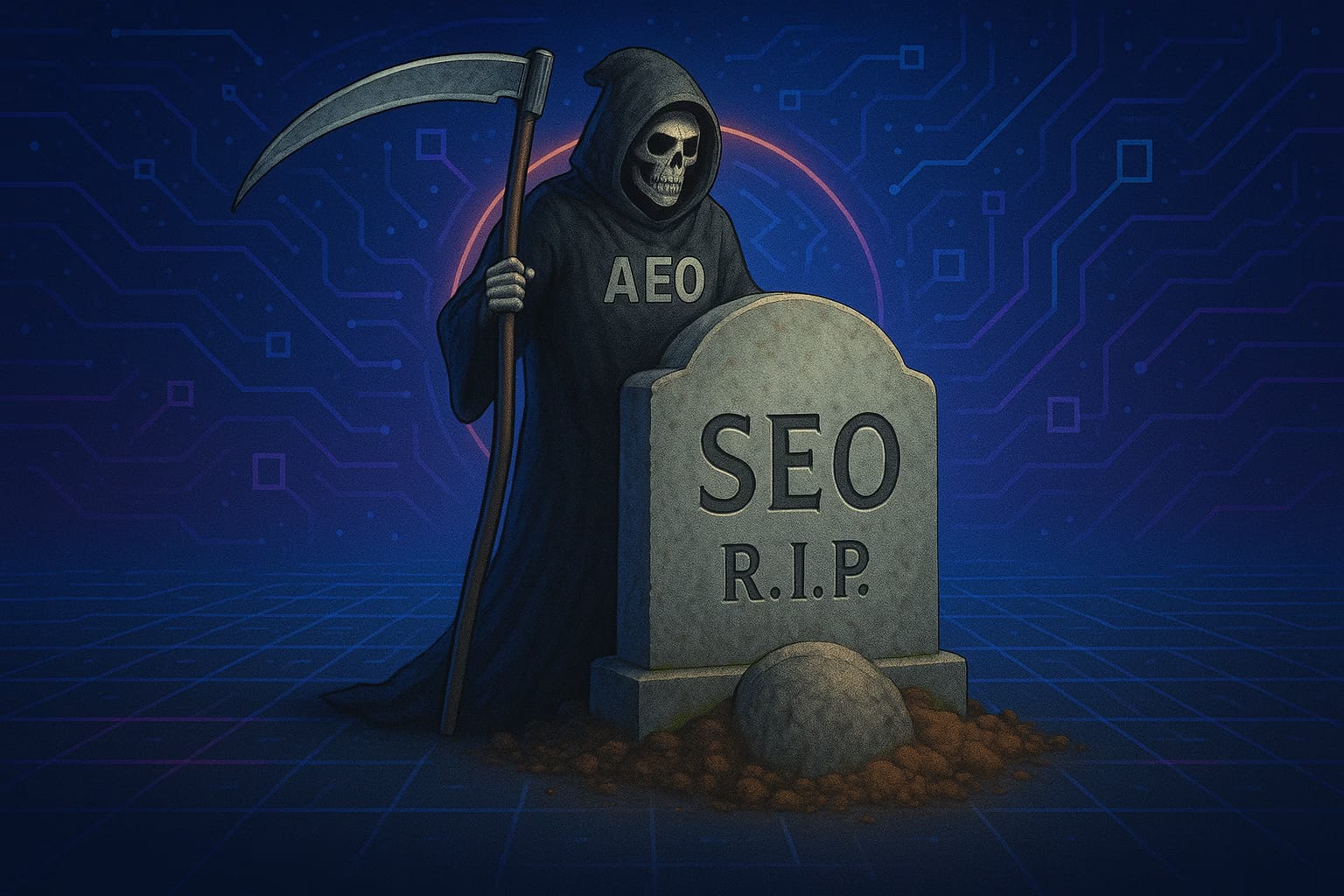As fellow digital marketers, staying ahead of the curve is not just part of the job; it’s our core mandate. For years, Search Engine Optimisation (SEO) has been a central pillar of our strategies. However, the digital landscape, as of May 2025, is undergoing a seismic shift, primarily driven by Artificial Intelligence (AI). This brings a critical new discipline to the forefront of our practice: Answer Engine Optimisation (AEO).
Let’s be clear: SEO isn’t becoming obsolete. It remains the bedrock of organic visibility and authority for our clients or our own brands. But AEO is its vital new strategic partner, essential for ensuring the campaigns we run are effective in an era where users demand instant, direct answers from AI tools like ChatGPT, Google’s ever-evolving AI Overviews, and voice assistants.
This isn’t just another industry buzzword. It’s a fundamental change in how information is sought and delivered, and it directly impacts our campaign performance and client success. Let’s unpack what this means for us, as digital marketing professionals, right now.
SEO & AEO: Understanding the Core Shift in Information Discovery
- Traditional SEO (Our Enduring Foundation): As we live and breathe, SEO encompasses all strategies to improve website rankings in traditional search engine results pages (SERPs like Google and Bing). Our primary objective has always been to increase qualified organic traffic to the websites we manage. This involves meticulous keyword research (including long-tail keywords indicating specific user intent), crafting high-quality, valuable content, optimising user experience (UX), ensuring technical SEO best practices for crawlability, on-page optimisation (titles, meta descriptions, headers), and off-page efforts like strategic backlink acquisition to build domain authority. This has been our craft for connecting brands with their target audiences.
- Answer Engine Optimisation (The New Imperative): AEO, a more recent but increasingly critical approach for us, focuses on meticulously optimising content to provide direct, concise answers within AI-powered search interfaces, those prominent “featured snippets,” and, crucially, voice search results. The goal of AEO isn’t solely to drive a click; it’s for the brands we represent to be the authoritative answer itself. This builds immediate brand credibility and delivers value, even if a user doesn’t click through to the website immediately.
The driving force behind this evolution? It’s twofold: the exponential advancements in AI, particularly in Natural Language Processing (NLP) enabling machines to understand and generate human-like text, and a significant shift in user behaviour. Users now expect, and often demand, immediate, highly relevant information without sifting through pages of links. AEO is our strategic response to ensure our clients and brands meet these evolving expectations.
Why AEO is a Non-Negotiable Priority for Your Campaigns in 2025
Integrating AEO into our digital marketing strategies is no longer a “nice-to-have”; it’s essential for sustained campaign success. Here’s why it’s so crucial for us now:
- The AI-Powered Search Experience is Mainstream: AI tools like ChatGPT, Perplexity, and Google’s AI Overviews are fundamentally altering how users discover information. These platforms often synthesise answers directly at the top of the results, sometimes pushing traditional organic listings further down. With data suggesting AI-driven search now influences a significant portion of all queries (the source material indicates over 50%), failing to optimise for AEO means risking dramatically reduced visibility for the campaigns and brands we manage. These AI systems are effectively becoming new informational gatekeepers.
- Conversational & Voice Search are Dominant: The trend away from terse keywords towards natural, conversational language queries is undeniable and accelerating. The proliferation of voice assistants (Siri, Alexa, Google Assistant) means users are increasingly “asking” for information. Reports from the source material highlight that over 58% of search queries are now conversational. AEO is specifically designed to cater to this context-based, natural language interaction, making the brands we manage discoverable through the way people naturally speak and seek answers.
- The Unparalleled Power of the Direct Answer: In our information-saturated digital world, users value speed and directness. AEO helps the brands we market deliver this. When our client’s content provides the answer in a featured snippet, an AI summary, or a voice response, it dramatically boosts brand visibility (often to “Position Zero,” above all other results). More importantly, it establishes the brand as an authoritative, trustworthy source in its niche. This isn’t just about impressions; it’s about building deep credibility. An AI citing our client’s content acts as a strong, implicit endorsement. While this might sometimes lead to “zero-click searches” (where the user gets the answer without a direct site visit), the brand authority and trust built can lead to more qualified downstream conversions and higher-intent traffic when users do seek further engagement.
Key Differences: SEO vs. AEO at a Glance (And What It Means for Our Strategies)
Understanding these distinctions is vital for how we plan, execute, and measure our digital marketing campaigns:
| Feature | SEO (Search Engine Optimisation) | AEO (Answer Engine Optimisation) |
|---|---|---|
| Primary Goal | Drive qualified traffic to a website via higher SERP rankings. Success is measured by clicks, traffic volume, on-site conversions, and keyword performance. | Be the direct, authoritative answer within search interfaces. Success includes visibility in snippets, voice responses, brand authority, and share of voice in answer formats. |
| Content Focus | Often longer-form, comprehensive content designed for in-depth exploration on a website. Supports various user intents across the funnel. | Concise, “snippet-ready” Q&As, direct answers (often under 40-60 words). Primarily targets “Know” and “Know Simple” informational intents. |
| Optimisation | Keywords, on-page/off-page technicals, backlink profiles, overall website user experience. | Structured data (Schema), question-focused content architecture, clarity for AI language model interpretation, conversational language optimisation. |
| Platforms | Traditional search engines (Google, Bing) via browsers. | AI-powered answer engines (ChatGPT, Perplexity), Google AI Overviews, voice assistants, structured data-driven results (knowledge panels). |
Strategic Implication for Us Digital Marketers: This framework demands a shift from solely chasing rankings to also strategically pursuing “answer ownership.” SEO builds the foundational authority and comprehensive resources; AEO leverages this to provide the immediate, trusted answers users now seek.
Making AEO Work for Your Campaigns: Practical, Actionable Steps
So, how do we, as digital marketing professionals, integrate AEO effectively into our workflows?
- Craft AEO-Friendly Content – Adopt an “Answer-First” Approach:
- Directly Address User Queries: Conduct thorough research into the specific questions your target audience is asking at each stage of their journey.
- Lead with the Answer: Structure content to provide the core answer in the initial sentences. Brevity is crucial for snippets; aim for 40-60 words for these direct answers.
- Question-Based Architecture: Use actual questions as headings (H2, H3 tags) followed immediately by the answer. This creates a clear path for AI parsing.
- Format for Readability & Machines: Employ bullet points, numbered lists, short paragraphs, and bold text for key terms. This aids both human scannability and AI extraction.
- E-E-A-T (Experience, Expertise, Authoritativeness, Trustworthiness) is Non-Negotiable: This Google guideline is even more critical for AEO success. AI is programmed to prioritise credible, accurate, well-researched information. Ensure content clearly demonstrates E-E-A-T.
- Develop “Hidden Gem” Content: Differentiate your client’s content by publishing original research, unique industry insights, or proprietary data that AI models cannot easily replicate from other sources.
- Embrace Structured Data (Schema Markup) – Communicate Clearly with AI:
- Schema markup is a vocabulary of tags added to a website’s HTML. It doesn’t alter the visual front-end but provides explicit context to search engines and AI about the content’s meaning and relationships.
- Why it’s crucial for AEO: It significantly improves how AI systems understand, interpret, and extract content for direct answers, rich snippets, and knowledge panels.
- Key schemas for AEO include
FAQPage(for Q&A lists),HowTo(for instructional content), andQAPage. Entity-based schemas likeOrganizationandProductare also vital. - Correct and comprehensive implementation is moving from a best practice to an essential requirement.
- Optimise for Key AEO Channels – Ensure Presence Where Answers Are Delivered:
- Voice Search: Optimise content using natural, conversational language patterns. Focus on long-tail, full-sentence question keywords. For local campaigns, “near me” and location-specific voice queries are critical. Featured snippets are frequently used as sources for voice answers.
- Featured Snippets (“Position Zero”): Target these by providing very concise, well-formatted answers (40-60 words) directly under a clear, question-phrased heading. Actively research and target questions appearing in Google’s “People Also Ask” (PAA) boxes.
- AI Citations (e.g., Google AI Overviews, ChatGPT responses): Strong traditional SEO performance (often requiring a top 10 organic ranking) is typically a prerequisite for consideration in Google’s AI Overviews. Ensure content is easily crawlable and accessible, and continuously reinforce E-E-A-T signals.
The Winning Strategy for 2025 and Beyond: Integrated SEO + AEO Campaigns
AEO doesn’t operate in isolation; its effectiveness is significantly amplified by a strong SEO foundation. High domain authority, quality backlinks, and comprehensive, well-optimised content (all outcomes of solid SEO work) position a website as a more trusted and reliable source for AI to extract answers from.
Our Integrated Approach for Maximum Campaign Impact:
- Maintain and Strengthen SEO Fundamentals: This is the launchpad for AEO success. Continue to prioritise creating valuable, in-depth content, robust technical SEO, and building domain authority.
- Strategically Layer AEO Tactics: Upon this strong SEO base, integrate AEO practices: structure key content pieces for direct answers, implement comprehensive schema markup, and target conversational query opportunities.
- Develop a Holistic Content Ecosystem: Provide both immediate, AEO-optimised answers for quick informational needs and the comprehensive, SEO-rich content that allows users to delve deeper.
- Evolve Campaign Measurement & Reporting: Success metrics must expand beyond traditional SEO KPIs. Track AEO-specific indicators: frequency of featured snippet appearances, voice search response inclusion, share of voice in “People Also Ask,” performance in zero-click scenarios, and citation frequency in AI overviews.
Future-Proofing Your Digital Marketing Expertise in the Age of AI
The AI-driven evolution of search is rapid and ongoing. As digital marketers, our adaptability is key. To stay effective and provide maximum value:
- Embrace the Hybrid SEO + AEO Model: Champion this integrated approach within your teams and for your clients.
- Prioritise High-Quality, E-E-A-T Driven Content: This remains the cornerstone of success in an AI landscape that increasingly scrutinises source credibility.
- Master and Mandate Structured Data Implementation: Ensure this becomes a standard, non-negotiable component of your content and technical SEO workflows.
- Stay Agile, Monitor, and Adapt: The AI search space is dynamic. Commit to continuous learning, testing, and refinement of AEO strategies.
- Keep an Eye on Emerging Trends: Concepts like Generative Engine Optimization (GEO) are gaining traction. GEO focuses on optimising content so AI can use it to synthesise new, generative responses, not just extract direct answers. This signals an even deeper need for rich, contextual, and easily interpretable content.
By proactively integrating AEO into our digital marketing strategies, we are not just reacting to technological shifts; we are strategically positioning the brands we manage for sustained visibility, enhanced authority, and deeper engagement in this exciting new era of search.

